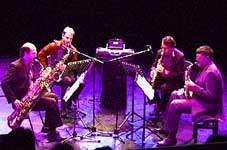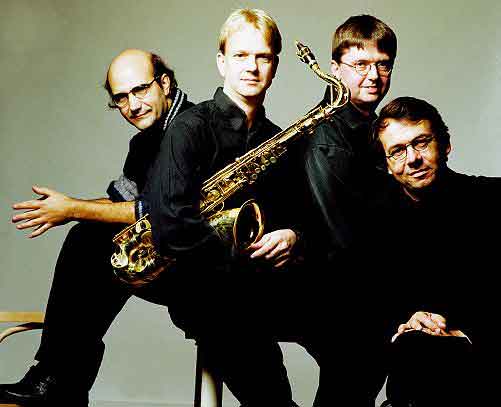
JACOB TER VELDHUIS - MUSIC FOR SAXOPHONE
WORKS FOR SAX OPHONES SOLO + GHETTOBLASTER:
GRAB IT! (1999)
for tenor saxophone and ghettoblaster
for Arno Bornkamp
duration: 9'45''
commissioned by FCM
recorded on cd by:
Arno Bornkamp on: Jacob ter Veldhuis - Heartbreakers, Emergo Classics 3920-2
Fabien Chouraki on: Paysaginaire, Visages Socadisc VDS-005 ISRC FR-95U
NB
: soon available in a longer version with extra improvisation
sections
NB: both
versions also soon available in dvd format, containing a stunning video
by Michiel Zegers for multimedia purposes!
available from March 2004
published by BOOMBOX MUSIC PUBLISHERS
new!
BILLIE (2003)
for alto saxophone and ghettoblaster
duration 10'
commissioned by Connie Frigo
published by BOOMBOX MUSIC PUBLISHERS
available from March 2004
new! THE
GARDEN OF LOVE (2001)
for soprano saxophone and ghettoblaster
duration 7'19''
published by BOOMBOX MUSIC PUBLISHERS
PITCH BLACK (1998)
for saxophone quartet and ghetto blaster
duration: 12'
commissioned by FCM / Kamermuziekvereniging Almelo, for the Aurelia Saxophone Quartet
published by BOOMBOX MUSIC PUBLISHERS
POSTNUCLEAR WINTERSCENARIO NO.10
for saxophone quartet (1991-2001)
duration 12'
published by BOOMBOX MUSIC PUBLISHERS
new!
JESUS IS COMING (2003)
for saxophone quartet & ghettoblaster
duration 11'
published by BOOMBOX MUSIC PUBLISHERS
available from March 2004
BOOMBOX MUSIC PUBLISHERS
Drift 40
3941DC Doorn
The Netherlands
00 31 343 421444
FCM = commissioned by the Funds for the Creation of Music
WORKS FOR SAX & ORCHESTRA:
GRAB IT! XXL (2003)
for solo saxophone(s) big band, string orchestra
duration: 13'
commissioned by NPS
with a video by Michiel Zegers
published by BOOMBOX MUSIC PUBLISHERS
Tallahatchie Concerto (
2001)
for alto saxophone and orchestra
pic/fl, fl, ob, Bb cl, bass cl, bsn, dbsn, top, trb, perc,
str ( 8,6,5,4,2 till 12,10, 8, 6, 3)
duration: 19'
commissioned by
FCM
first performance & radio recording 3-3-2002 by Arno Bornkamp &
Dutch Radio Chamber Orchestra, conducted by Thierry Fischer
published by MGN-DONEMUS AMSTERDAM
 |
Written in 1998 for the Aurelia Saxophone Quartet * commissioned by the Almelo Chamber Music Society and the Dutch Fund for the Creation of Music. Pitch Black was recorded on cd ( Jacob ter Veldhuis - Heartbreakers, Emergo Classics 3920-2.) The ghettoblaster reproduces the voice of trumpetplayer Chet Baker, from one of the last interviews before his tragic death by falling out of an Amsterdam hotel room window in 1988. Baker talks about his past as a drug addict,his life in prison ('it was pitch black in there you know' ) his first audition with Charlie Parker ( 'among 40 other trumpetplayers - or were there 60 ? ') and playing without drums ( 'more cool' ). In Pitch Black, the 'melody'and rhythm of the spoken word samples form the basics. Pitch Black is part of a sequence of several ghettoblaster compositions that Ter Veldhuis wrote in the late 90ís, like ëMay this bliss never end, Lipstick, Grab it ! , Heartbreakers, The Storm and Tatatata. Pitch Black is arepertoire piece of the Aurelia Saxophone Quartet. |
|
Pitch Black |
|
GRAB IT! - for tenor saxophone
& ghettoblaster
*Written November 1999
*Commissioned by the Dutch 'Fonds voor de Scheppende Toonkunst' *Dedicated to Arno
Bornkamp
*performed by Arno many times, also at the World Saxophone Congres in Montreal in
July 2000. In it sort existence Grab it! has become a repertoire piece, now performed
by many players around the world. GRAB IT! was recorded on cd ( Jacob ter Veldhuis
- Heartbreakers, Emergo Classics 3920-2.)
The saxophone reminds me of the recent American history of music that I grew up with,
and which had such a strong impact on my own music. Out of a fascinating mixture
of influences from black and white cultures, musical genres like blues,jazz, rockíníroll,
soul and rap came into being during the last century. The roots of all these different
musical styles can be found in the American language,in the spoken word. In my opinion,
spoken word is one of the origins of music. So I decided to write a piece in which
the saxophone is confronted with American slang,. I recorded an American documentary
calledîScared straightî about juvenile deliquency, in which life sentenced prisoners
played an important role.Their world, on the fringe of society, with its heartbreaking
verbal assaults moved me deeply and inspired me. The vitality and the sound of the
shouting men formed a perfect unity with the harsh and powerful sound of the tenor
saxophone. Grab it! is a kind of duet, a 'duelí if you like, for tenor and tape,
the latter being reproduced by a ghetto blaster. The tenor competes unisono with
an almost endless rage of syllables, words and sentences, demanding a lot of endurance
of the performer. The meaning of the lyrics becomes gradually clear during the piece,
as well as the hopeless situation for the prisoners. Suicide is not uncommon: 'He
tied one end around the pipe, and he hung himself. So he went out the back door rapped
up in a green sheet with a tag on his toe....You lose everything!' That last line
goes for everyone: death row as a metaphor for our earthly lives. Yet the piece is
meant to have a positive meaning, that can be understood as a kind of ëmemento vivereí.
Life is worth living: Grab it!
|
GRAB IT! |
|
Tallahatchie Concerto for saxophone
& orchestra was written in 2001 with financial support from the ëFonds voor de Scheppende
Toonkunstí by request of the NCRV and is dedicated to Arno Bornkamp.
First performance including a radio broadcast by the NCRV is on March 3 2002, at
Vredenburg, Utrecht, by Arno Bornkamp and the Radio Kamerorkest conducted by Thierry
Fischer.
The Tallahatchie Concerto is the first piece that I wrote after the oratorio Paradiso,
my ëmagnum opusí so far. This is the reason why ëpink shadows of heavenly orange
cloudsí hang over the opening adagietto of the piece. The concerto is in fact a stretched
out crescendo/accelerando, in which the saxophone gradually leads us from celestial
atmospheres into terrestrial ones.
I regard this concerto as an abstract piece of music, which is quite exceptional
in my work, because I love to connect an anecdote to each composition. All I can
say about the piece is, that the word ëtallahatchieí occurred to me spontanuously.
It appeared to be a native-American word, meaning ëriver of rocksí, which is in my
opinion an apt metaphor for this concerto. I also think that there is some similarity
with pieces like ëLes Soupirs de Rameauí, the ëGoldrush Concertoí or my third string
quartet ëThere must be some way out of hereí All these works are ëdreamed expeditionsí,
composed voyages of discovery for moments of beauty, bliss and extasy.
Postnuclear Winterscenario No.10 for saxophone quartet
Postnuclear Winterscenario opus 49 was written on January 23 1991, shortly after
the Gulf War broke out.In those days Ter Veldhuis felt speechless and unable to compose.In
the media,meteorologists predicted apocalyptical consequences for the climate and
the environment, similar to the effects of a nuclear war.They called it a postnuclear
winterscenario .Ter Veldhuis decided to express his speechlessness in music.In
only a few hours time the piece,for piano solo,was written.It is probably the simpliest
music he ever wrote.All musical material was reduced to a minimum.The 'melody' consists
of one single note,that is repeated all the time.The harmonic accompaniment consists
of only four different notes. There are no real rhythmical, melodical or harmonical
developments in Postnuclear Winterscenario. The main way of expression is in the
repetition and the delivery.Pianist Kees Wieringa performed the piece worldwide,
even in Irak, on the ruins of Babylon.Ter Veldhuis regards his ëPostnuclearías a
centerpiece and has already written several other íscenariosí, all based on the first
one. Postnuclear Winterscenario No.11, based on the string quartet version, was arranged
in the summer of 2001 by request of the Aurelia Quartet.